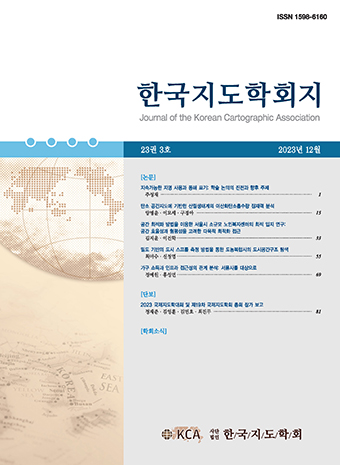Research Article
Abstract
References
Information
This study aimed to analyze the carbon sequestration potential of forest ecosystems, which served as important carbon sinks, and thus to create a carbon spatial map. The research was implemented at national scale and local scales including provinces, cities, counties, and districts. After calculating the areas of coniferous forests, non-coniferous forests, mixed forests, evergreen broad-leaved forests, and bamboo forests, we applied the carbon sink coefficient of each vegetation type and calculated the amount of carbon sink at local and national levels. The results showed that the entire forest land absorbed about 56,352,485t CO2/yr in 2010, 55,391,298t CO2/yr in 2015, and 52,633,417t CO2/yr in 2020, declining over time. The decline in forest area was a major reason for the decline. The changes in the species composition of each vegetation could partially contribute to the decline. We also obtained the carbon absorptions for evergreen broad-leaved forests (about 55,928 t CO2/yr) and bamboo forests (about 591,183.4 t CO2/yr). At the local government scale, we found that cities, counties, and districts including the Taebaek Mountains and Sobaek Mountains had higher carbon sinks than others, and large cities had relatively lower carbon sinks. In conclusion, it is necessary to upgrade the calculation system in the management of the forest ecosystem as a carbon sink to achieve carbon neutrality in Korea. Considering that the most important factor in reducing carbon absorption is the reduction of forest area, the establishment and implementation of active restoration policies to restore forest area are required, and sustainable management for conservation and expansion of vegetation with high carbon absorption such as bamboo forests. In particular, in order to recover the forest ecosystem, it is urgent to develop area-based forest management plans at the local government level and watershed-based integrated forest management policy and implementation plans at the regional level.
본 연구는 중요한 탄소흡수원의 역할을 하는 산림생태계 탄소흡수 잠재력을 분석하고 이를 통해 탄소 공간지도 제작을 목표로 한다. 연구지역은 대한민국 전역으로, 시도 및 시군구의 공간 단위로 분석을 진행하였으며. 첫째, 침엽수림(Conifers), 활엽수림(Non-Conifers), 혼효림(Mixed), 상록활엽수림(Evergreen broadleaf forests), 죽림(Bamboo)의 면적을 지역별로 산정한 후, 이들 면적에 대한 연간 이산화탄소흡수량 고유계수를 적용하여 지역별 이산화탄소흡수량과 전국 단위의 흡수량을 계산하였다. 분석결과, 전체 산림지의 이산화탄소흡수량은 2010년 56,352,485t CO2/yr, 2015년 55,391,298t CO2/yr, 2020년 52,633,417t CO2/yr로 감소하는 것으로 나타났다. 산림면적의 감소가 주요 감소 원인으로 분석되었고, 부분적으로 기후변화 등에 따른 식생의 종조성 변화도 원인으로 나타났다. 이에 더하여, 상록활엽수림 및 죽림의 면적을 기반으로 탄소흡수량을 분석한 결과 상록활엽수는 55,928t CO2/yr, 죽림은 591,183.4t CO2/yr의 이산화탄소흡수량을 얻을 수 있었다. 지자체별 탄소흡수량 분석결과에서는 태백산맥, 소백산맥을 포함하고 있는 시군구가 다른 지역에 비해 산림지역의 이산화탄소흡수량이 많다는 것을 파악되었고, 대구광역시, 광주광역시, 대전광역시 등 대도시 인접 지역은 상대적으로 이산화탄소흡수량이 적음을 확인할 수 있었다. 결론적으로, 우리나라 탄소중립 실현을 위한 탄소흡수원으로써 산림지의 관리에 있어서 산정체계의 고도화가 필요하다. 특히 기후변화에 따라 변화될 식생대의 분포와 식생별 수목의 종조성 변화를 고려한 임목별 연령별 흡수계수 산정 자료 구축이 필요하다. 본 연구에서 제시한 상록활엽수와 죽림의 경우가 중요한 예시가 될 것이다. 또한, 탄소흡수량 감소에 가장 중요한 요인이 산림면적 감소인 것을 고려할 때, 산림지 면적의 회복을 위한 적극적인 복원 정책의 수립과 이행이 요구되며, 죽림 등 탄소흡수량이 높은 식생의 보전, 확대를 위한 지속 가능한 관리 정책 마련이 필요하다. 특히, 산림면적의 회복을 위하여 지자체 단위에서 면적 기반 산림관리와 지역 단위에서 유역기반의 통합된 산림관리 정책과 이행 방안 마련이 시급하다.
- 구경아・오일찬・홍현정・명수정・김준성・권봉오・양병윤, 2022, 「생물다양성보전을 통한 탄소흡수원 확대 방안 (I)」, 한국환경연구원.
- 국립산림과학원, 2013, 「주요 산림수종의 표준 탄소흡수량」.
- 국토교통부 국토지리정보원, 2020, 「대한민국 국가지도집 II」.
- 국토교통부, ‘“탄소공간지도 시스템”, https://carbonmap.kr/space.do (2023.11 검색)
- 기상청・국립기상과학원, 2021, 「우리나라 109년(1912년~2020년) 기후변화 분석 보고서」.
- 박종철・양금철・장동호, 2010, “기후변화에 따른 난온대 상록활엽수림대의 이동에 관한 연구,” 기후연구, 5(1), 29-41.
- 산림청, 2011, 「2010년 산림기본통계」.
- 산림청, 2016, 「2015년 산림기본통계」.
- 산림청, 2021, 「2020년 산림기본통계」.
- 손영모・김래현・이경학・표정기・김소원・황정순・이선정・박현, 2014, 「한국 주요 수종별 탄소배출계수 및 바이오매스 상대생장식」, 국립산림과학원.
- 안현진・석현덕・최준영・김동훈, 2017, 「제9장 신기후체제 대응을 위한 산림관리」, 한국농촌경제연구원.
- 유병오・정수영・박용배・이광수・박준형, 2018, 「대나무 자원의 인벤토리 구축 및 임분관리기술 개발」, 국립산림과학원.
- 이은미・이상헌・조경남・김용미, 2017, “한반도 기후민감성 상록활엽수 지시종 현생화분의 형태분류학적 특성,” 지질학회지, 53(6), 833-844. 10.14770/jgsk.2017.53.6.833
- 임종환・신준환, 2005, “지구온난화에 따른 산림식생대 이동과 식물계절 변화,” 자연보존, 130, 8-17.
- 조현국・김종찬・정일빈・손영모・임종수・이선정, 2017, 「숫자로 보는 우리나라의 산림자원」, 한국임업진흥원.
- 최원준・한수현・안세진, 2022, 「온실가스 인벤토리 구축을 위한 LULUCF 산정체계 현황 및 시사점」, 녹색기술센터.
- 허인혜・권원태・전영문・이승호, 2006, “우리나라에서 기온 상승이 식생분포에 미치는 영향 -대나무와 마늘을 중심으로,” 환경영향평가, 15(1), 67-78.
- 환경부 온실가스종합정보센터, 2021, 「2020년 국가 온실가스 인벤토리 보고서」.
- 환경부 온실가스종합정보센터, 2022, 「2021년 국가 온실가스 인벤토리 보고서」.
- Byun, J.G., Lee, W.K., Kim, M., Kwak, D.A., Kwak, H., Park, T., and Jung, J.H., 2013, Radial growth response of Pinus densiflora and Quercus spp. to topographic and climatic factors in South Korea, Journal of Plant Ecology, 6(5), 380-392. 10.1093/jpe/rtt001
- Chen, K., Cai, Q., Zheng, N., Li, Y., Lin, C., and Li, Y., 2021, Forest carbon sink evaluation – An important contribution for carbon neutrality, IOP Conference Series: Earth and Environmental Science, 811(1), 012009. 10.1088/1755-1315/811/1/012009
- Iizuka, K. and Tateishi, R., 2015, Estimation of CO2 sequestration by the forests in Japan by discriminating precise tree age category using remote sensing techniques, Remote Sensing, 7(11), 15082-15113. 10.3390/rs71115082
- Keenan, T.F. and Williams, C.A., 2018, The terrestrial carbon sink, Annual Review of Environment and Resources, 43(1), 219-243. 10.1146/annurev-environ-102017-030204
- 산림청 산림임업용어사전, https://www.forest.go.kr/kfsweb/kfi/kfs/mwd/selectMtstWordDictionaryList.do?mn=NKFS_04_07_01
- Publisher :The Korean Cartographic Association
- Publisher(Ko) :한국지도학회
- Journal Title :Journal of the Korean Cartographic Association
- Journal Title(Ko) :한국지도학회지
- Volume : 23
- No :3
- Pages :15-32
- DOI :https://doi.org/10.16879/jkca.2023.23.3.015



 Journal of the Korean Cartographic Association
Journal of the Korean Cartographic Association





